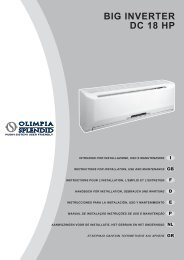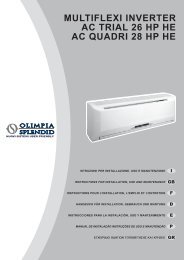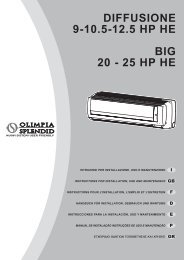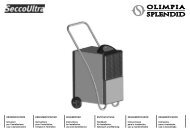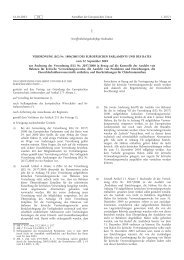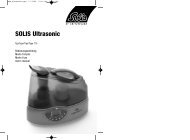GAMMA STAR - Olimpia Splendid
GAMMA STAR - Olimpia Splendid
GAMMA STAR - Olimpia Splendid
You also want an ePaper? Increase the reach of your titles
YUMPU automatically turns print PDFs into web optimized ePapers that Google loves.
28<br />
12<br />
2.3.2<br />
I<br />
In ogni caso è necessario un attento<br />
esame delle caratteristiche e della<br />
consistenza della parete per l’eventuale<br />
scelta di tasselli specifici a particolari<br />
situazioni.<br />
AVVERTENZA: Il costruttore non<br />
può essere ritenuto responsabile di<br />
eventuali sottovalutazioni della<br />
consistenza strutturale dell’ancoraggio<br />
predisposto dall’installatore.<br />
Invitiamo pertanto a fare la massima<br />
attenzione a questa operazione,<br />
che, se mal eseguita, può provocare<br />
gravissimi danni alle persone ed<br />
alle cose.<br />
Nel caso di apparecchi in pompa di<br />
calore per i quali non fosse stato<br />
predisposto uno scarico condensa<br />
incassato nella parete (vedi<br />
paragrafo 2.3.2), è necessario, per<br />
consentire il drenaggio della<br />
condensa stessa, eseguire un foro<br />
passante di diametro pari a 16 mm<br />
nella posizione indicata sulla dima<br />
(vedi fig.7).<br />
Predisposizione dello scarico<br />
condensa per le macchine<br />
in pompa di calore<br />
Durante il funzionamento in<br />
riscaldamento gli apparecchi producono<br />
condensa che deve essere<br />
smaltita con un apposita linea di<br />
scarico in assenza del quale la<br />
macchina non può funzionare.<br />
Il drenaggio avviene per gravità. Per<br />
questo motivo è indispensabile che<br />
la linea di scarico abbia una<br />
pendenza minima in ogni punto di<br />
almeno il 3%. Il tubo da utilizzare<br />
può essere rigido o flessibile con un<br />
diametro interno minimo di 16 mm.<br />
Nel caso che la linea sfoci in un<br />
sistema fognario, occorre eseguire<br />
una sifonatura prima dell’immissione<br />
del tubo nello scarico principale.<br />
Questo sifone dovrà trovarsi almeno<br />
300 mm sotto l’imbocco dall’apparecchio<br />
(fig. 8).<br />
8<br />
GB F D<br />
In any case, the wall should be<br />
inspected carefully to determine the<br />
best possible anchorage and type of<br />
bolts suitable for particular situations.<br />
WARNING: The manufacturer is not<br />
liable in case of underestimation of<br />
the structural consistency of the<br />
anchorage made at the time of<br />
installation. We therefore<br />
recommend that you perform this<br />
operation with the maximum care as,<br />
if not done properly, it can cause<br />
serious damage to persons and<br />
property.<br />
When installing models equipped with<br />
heating pump, if no drainage well for<br />
condensate has been provided built<br />
into the wall (see paragraph 2.3.2), it<br />
will be necessary, to allow for drainage<br />
of the condensate, to drill a hole<br />
through the wall measuring 16 mm in<br />
diameter in the position shown on<br />
the template (see fig.7).<br />
Provision for draining condensate<br />
for machines with<br />
heat pump<br />
When the machine is heating, it<br />
produces condensate that has to be<br />
eliminated through a specific drain<br />
line, otherwise the machine will not<br />
work. Drainage occurs by gravity. For<br />
this reason, it is essential for the<br />
drain line to have a minimum<br />
inclination of at least 3% throughout<br />
its length. The pipe can be rigid or<br />
not, with a minimum internal diameter<br />
of 16 mm.<br />
If the line drains into a sewer system,<br />
it should be provided with a trap<br />
ahead of the main outlet.<br />
The trap should be at least 300 mm<br />
lower than the inlet opening on the<br />
air conditioner (fig. 8).<br />
300 mm<br />
De toute façon il est nécessaire<br />
d'effectuer un examen attentif des<br />
caractéristiques et de la consistance<br />
du mur pour le choix éventuel des<br />
chevilles appropriées pour des<br />
situations particulières.<br />
AVERTISSEMENT: Le fabricant ne<br />
peut être tenu responsable des<br />
éventuelles sous-estimations de la<br />
consistance structurelle de<br />
l'ancrage effectué par l'installateur.<br />
Par conséquent, nous vous invitons<br />
à faire très attention à cette<br />
opération, qui, si elle est mal<br />
exécutée, peut provoquer de très<br />
graves dommages aux personnes<br />
et aux choses.<br />
Pour le cas d'appareils avec pompe<br />
à chaleur pour lesquels une sortie<br />
d'évacuation du condensat,<br />
encaissée dans le mur, n'aurait pas<br />
été prévue (voir paragraphe 2.3.2), il<br />
est nécessaire, pour permettre le<br />
drainage de ce condensat, d'effectuer<br />
un trou passant d'un diamètre de 16<br />
mm à la position indiquée sur le<br />
gabarit (voir fig.7).<br />
Préparation d'un système<br />
d'évacuation du condensat<br />
pour les machines avec<br />
pompe à chaleur<br />
Pendant le fonctionnement en mode<br />
chauffage, les appareils produisent<br />
de la condensation qu'il faut évacuer<br />
par un tuyau spécial d'écoulement,<br />
sans lequel la machine ne pourrait<br />
pas fonctionner. Le drainage<br />
s'effectue par gravité. C'est pourquoi<br />
il est indispensable que le tuyau<br />
d'évacuation ait une pente minimum<br />
sur toute sa longueur d'au moins 3%.<br />
Le tuyau peut être rigide ou flexible<br />
d'un diamètre intérieur de 16 mm au<br />
minimum.<br />
Au cas où le tuyau déboucherait dans<br />
un tout-à-l'égout, il faut effectuer un<br />
système de syphon avant<br />
l'introduction du tuyau dans<br />
l'écoulement principal.<br />
Ce siphon devra se trouver au moins<br />
300 mm en dessous de l'entrée de<br />
l'appareil (fig. 8).<br />
Auf jeden Fall ist die<br />
Widerstandsfähigkeit der Wand<br />
eingehend zu überprüfen, damit die<br />
geeigneten Dübel verwendet werden.<br />
HINWEIS: Der Hersteller kann nicht<br />
zur Verantwortung gezogen werden,<br />
wenn die Wand nicht der für die vom<br />
Installateur gewählten Verankerung<br />
standhält. Wir empfehlen deshalb, die<br />
Widerstandsfähigkeit der Wand einer<br />
eingehenden Überprüfung zu<br />
unterziehen, da eine nicht<br />
fachgerecht durchgeführte<br />
Verankerung zu schweren Schäden<br />
an Gegenständen oder zu schweren<br />
Körperverletzungen bei Personen<br />
führen könnte.<br />
Bei mit einer Wärmepumpe<br />
ausgestatteten Geräten, für die keine<br />
Kondenswasserablaufleitung in der<br />
Wand vorgesehen ist (siehe<br />
Abschnitt 2.3.2), ist für die Ableitung<br />
des Kondenswassers ein<br />
Durchgangsloch mit einem<br />
Durchmesser von 16 mm in der auf<br />
der Schablone angegebenen Position<br />
zu bohren (siehe Abb. 7).<br />
Vorbereitung der<br />
Kondenswasserablaufleitung<br />
für Geräte mit Wärmepumpe<br />
Im Modus “Heizung” erzeugt das<br />
Gerät Kondenswasser, das über eine<br />
dazu vorgesehene Ablaufleitung<br />
abgeleitet werden muss; ohne diese<br />
Ablaufleitung kann das Gerät nicht in<br />
Betrieb genommen werden. Die<br />
Ableitung des Kondenswassers<br />
erfolgt durch Schwerkraft. Aus diesem<br />
Grund ist es unbedingt erforderlich,<br />
dass die Ablaufleitung eine Neigung<br />
von mindestens 3% auf ihrer ganzen<br />
Länge aufweist. Es kann entweder<br />
ein Rohr oder ein Schlauch mit einem<br />
Innendurchmesser von mindestens<br />
16 mm verwendet werden.<br />
Führt die Ablaufleitung in die<br />
Kanalisation, ist sie mit einem Siphon<br />
auszustatten, bevor sie in die<br />
Hauptablaufleitung eingeführt wird.<br />
Dieser Siphon muss sich mindestens<br />
300 mm unterhalb der Tülle des<br />
Gerätes befinden (Abb. 8).



